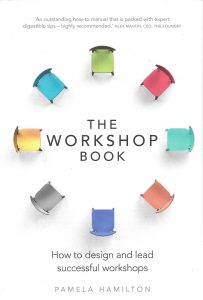The one sentence summary
Workshops can be a success if you design them properly and use the right techniques.
WHAT THE BOOK SAYS
· This is all about how to design and lead successful workshops.
WHAT’S GOOD ABOUT IT 
- It provides a set of techniques and exercises that you can match to your needs. These caught the eye:
- Idea stretcher: start with your initial idea; then push it to an impossible extreme version; then rein it back to merely innovative or ambitious, and see if it’s an improvement.
- Keep or grow: a good system for weeding out what needs developing.
- Ideas measure asks four questions:
- Does it fit the brand?
- Does it have a consumer need?
- Does it give us a competitive advantage?
- Is it easy to make?
- Rule breaker: write the rules of the product or category, and then write the extreme opposites and explore the space between.
- Newspaper/postcard/ storyboard: all these techniques involve writing headlines or articles from the future, forcing participants to envision their goals.
- Advice to myself 10 years ago: a close cousin, good for passing on experience.
- Future trends: brief description of trend; opportunities this offers the business; risks if we ignore it.
- Calibration: draw a vertical line down a chart. Put a tick on the left and a cross on the right. Then work through questions such as who is our customer, and (crucially) who is not?
- Identifying initiatives: name it, describe it, and then vote on it.
- Accountability template: project description, elements, opportunities, challenges, action in the next week, month, with responsibility names on it.
- Old way, new way: what’s the usual way of doing this, and how are we going to change it?
- Ideal job: what is it? Good for defining peoples’ motivations.
- Outputs not updates: get it done, don’t just keep telling everybody what you are doing.
- Be a problem owner, not a problem moaner.
- The three main ingredients of creativity are your field of expertise, the cultural context, and your personal experience. Mix them together and you are likely to generate a decent idea.
WHAT YOU HAVE TO WATCH
- Much of it is common sense and you may have seen a fair number of the techniques before.
